Why does the car rev so high? Why does the idle speed of the injection engine not fall. Which dpds sensor to choose for replacement
As with many other malfunctions, the causes of high idle engine speeds should be looked for from simple to complex. In fact, there can be many reasons for these, but among them are the most common:
- high idle due to air suction from the manifold(with subsequent hit in the engine);
- increased turnover for Idling due to a leak in the vacuum line;
- high revs at idle due to a malfunction of the ignition system engine.
As you can see, these reasons are rather "smeared", and they should be specified. But the first thing to do is the standard procedure - turn off the car, remove the negative battery terminal for 15-20 seconds, then connect it back and see if the problem remains.
High idle engine due to air leakage and vacuum line leakage
So, if the cause of high idle was excessive air entering the engine, then the first thing to do is check the cable throttle valve. Because of it, the damper may remain too open at idle, as a result of which the latter grow. This happens because the "brains" of the engine see that a lot of air (more precisely, oxygen) enters the manifold, and therefore correct the fuel supply, increasing it. As a result, the engine speed increases at idle. Cleaning the throttle body with special chemicals can help in this case.
More air can also enter the manifold due to a leak in the air intake system. In this case, all vacuum lines, head breathers and all sections of the air flow line to the engine should be checked for air suction. Listen for hissing sounds, which can be a key indicator of vacuum leaks and air leaks.
High idle due to problems in the ignition system
In this case, the reason lies in one of the details of the ignition system - also a fairly common cause of a problem with speed. Here you should check and, if necessary, replace the distributor cap, ignition wires or elementary spark plugs.
Other causes of increased idle speed and solutions:
- idle sensor. In principle, this malfunction should be included in the list of common ...
- Fuel pressure control can operate at too low a pressure. Check the fuel pressure with a special fuel pressure gauge. Replace the fuel pressure regulator if necessary (do not independent work for many drivers).
- Incorrectly installed or knocked down ignition timing(in this case, usually idle speed does not increase much).
- The reason may be malfunction in the computerized control system engine. Errors should be read with a diagnostic tool to identify the problem.
- Generator also sometimes causes high idle. If it doesn't work properly and doesn't generate enough current, then the motor will try to spin it even harder to balance the voltage.
- If you know what it looks like and where it is PCV valve and its hose then check them out. Using pliers, pinch the hose of this valve. The engine speed should drop slightly. If this does not happen, then the faulty valve is the cause of the increased engine speed - it needs to be replaced.
- Engine overheating or faulty sensor its temperatures in rare cases can also cause high idle speeds.
As you know from Civic diseases, the most pressing issues are the rear arches, oil consumption, water in the trunk. But there is another small issue, but very common, I'm talking about the problem of floating idle and too high speed when the engine is running without load.
Engine speed floats or jumps at idle - this means that there is no stability of the engine without load, meaning gearboxes. Let's say you warm up the car, put the gear in neutral, and you see on the tachometer how the arrow starts to jump 1000-1500, 2000-2500 rpm, if your muffler is also torn, then the neighbors also notice it. Sometimes the speed starts to jump immediately after the factory, it happens that they jump after a little warming up. But when the gear is engaged, that is, when a load appears, the revolutions normalize and fall, in the Honda Civic, to set 750-800 RPM. Consider the problem of unstable engine speeds in detail.
We set the conditions of the problem
Firstly, we will immediately discard the option when the engine has undergone brain replacement or firmware, such guys should not have problems with idling, since it may not exist at all, but this is separate. As an example, a stock 6th or 5th generation Honda Civic is considered, with a standard or standard intake manifold, and an IACV or RACV idle valve, and intact MAP sensors.
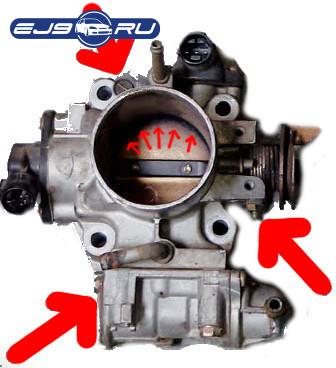
Causes and elimination of high speeds
If after some alterations on the intake manifold or throttle valve, such as replacing or cleaning with Carbcleaner, adjusting the throttle and automatic transmission cables, your speed has risen, most likely this is air leak. After installing VTEC, I changed the throttle from D14 to D16 and the first problem at startup was just in the revs in neutral, they immediately jumped to 5000.
The first thing I did was throw off the gas and kickdown cable, I could pull them and the "pivot" throttle not fully closed.
Second, increased but stable high speeds, as I said - air leakage, perhaps the "butterfly" of the damper is not completely closed for other reasons. The swivel ear in the closed state rests against the calibration screw, with which you can adjust the idle speed. Do not try to unscrew it at all, since the throttle spring is designed to close the throttle not by 100% but a little more, that is, without a locking calibration bolt, the throttle ear does not stop at the closing point but passes by and opens again. I removed the throttle and adjusted the gap to the clearance of the "butterfly".
Third, I had an old throttle body that I didn't clean, which was a mistake. With the engine off, I opened the throttle to 90 degrees and saw soot ring inside the throttle valve and on the edge of the throttle butterfly itself. Carbon deposits, caused by improper operation of the PCV valve, did not allow the throttle to close. With a carb cleaner and a rag or fine grit sandpaper, I removed the carbon ring and cleaned the throttle butterfly rib.
Fourth, there is a screw for a slotted screwdriver on the left side of the throttle valve, this air screw, also a kind of idle setting. Let's say your throttle valve is completely closed, how to make the engine work with the throttle closed if air is not supplied in the right amount? You need a small diameter bypass with an adjusting screw. The adjusting screw closes the channel. I cleaned the channel on the removed throttle, and purely "by eye" found the middle position, later, when the engine was running, I calibrated it more precisely and set the same 800 idle speeds.
The fifth reason for floating idle speed may not be correctly selected or torn throttle body gasket. For 15-20 years, the throttle valve gasket got wet, in some places had poor insulation, as a result of which there was another way for air to be sucked into the engine.

Intermediate result
The five reasons that I have given above are the solution for almost most cars, not just the Honda Civic. This is a rough setting - the base. Providing conditions for the engine to idle. All this saves you from high idle, but not from floating revolutions. The reason for the floating speed is the idle valve IACV or RACV.
Difference between IACV and RACV
Until the 6th generation, the IACV (Idle Air Control Valve) valve was used; in subsequent models, the RACV (Rotary Air Control Valve) was installed. The difference between IACV and RACV is in the way the air is blocked (one more channel). The IACV uses a solenoid-piston, which, when voltage is applied, closes the channel by the desired amount, thanks to the ECU commands. RACV works like a water faucet, it has a rotary mechanism, when the mechanism is turned, a more accurate shutoff of the channel by the required number of degrees is achieved. Agree that to block a channel with a diameter of 0.5 cm, there will be more opportunities with a turn phase than with sequential overlap.
Causes and elimination of floating revolutions
You fixed problems with the throttle and intake manifold, adjusted the tension of the cables and the air leak screw in gear with an assistant. But in neutral the revs still fluctuate. The reason is a defective or dirty idle valve. In both valves, due to external contamination, and especially a malfunctioning crankcase ventilation system or right choice cleaning agent such as tap water with soap (and this happened), the mechanisms are covered with soot or other compounds that block the internal channels of the course. Metal burrs can also appear during valve operation. Therefore, carefully disassemble the valve, clean the stem and assemble it back. As a result, the movement of the valve should be as light as the movement of a working bearing. By the way, there are two bearings on the RACV axle, which, in case of destruction, will need to be replaced
To check the RACV valve, you can measure the resistance between the middle and outer contacts. If the resistance is within 20-25 ohms, then the "controller" itself is working, you just need to clean the idle mechanism. If there is a break, very high resistance, the valve will have to be replaced.

Removed valve RACV D14, it can be seen that the coolant passes through without "braking"
Why do you need to pass coolant through the idle valve
The coolant circulating through the Honda Civic idle valve has two functions. First active function: in any of the RACV-IACV valves there is a thermocouple, whether it is a thermistor or a temperature sensor. He participates in feedback with idle valve clearance setting. Higher temperature, less gap.
The second function, is passive. As you understand, any power element such as a solenoid begins to heat up at a constant voltage, the coolant circulation takes away excess heat from the power element, preventing overheating.
The first time, after replacing the intake manifold, from vertical to horizontal, I left the throttle from D14 and did not connect the coolant circulation. To be honest, I did not notice a difference in a year of active driving. Neither winter nor summer.
This article is relevant for 1992-2000 Honda vehicles such as Civic EJ9, Civic EK3, CIVIC EK2, CIVIC EK4 (partially). The information will be relevant for owners of Honda Integra in DB6, DC1 bodies, with ZC, D15B, D16A engines.
Helpful Hints: To facilitate the search for the TDC mark on the crankshaft pulley, mark the mark with white paint or clerical putty. Full list of tips
For most questions, the community can help you.
Instruction
It should be said right away that in a cold engine, immediately after switching on, it works for some time at high idle. This is necessary for it to warm up. That is, it is easy to guess that winter time year of the year, after switching on, the engine will run longer at higher idling speeds than in summer. The normal RPM for most cars is about 1000 rpm. You can find the exact level recommended for your car in the owner's manual. If turns your car's idle speed does not drop after the engine has warmed up, or "float", you need to look for a malfunction.
First you need to find out what type of engine is installed in your car - injection or carburetor. If you have a carbureted engine, you can easily set it up yourself. If the car is of considerable age, the carburetor should be removed and cleaned, as a clogged carburetor is often the cause of high idle engine speeds. If you do not have experience in setting up and flushing a carburetor, it is better to entrust this procedure to knowledgeable people who can quickly and efficiently repair it.
Carefully check all rubber gaskets and hoses. A torn gasket can also cause high idle, as more air will enter the system than it should be. Pay special attention to the pipes and gaskets leading to the intake manifold. Try to gently outlive the rubber hoses, in parallel, watch the speed. If they fall down when you press on any hose, it means that you have found the cause of the problem. Pay attention to all connections. Worn clamps should be replaced as they can loosen the hoses and allow air to leak out.
If your car has an injection engine, it is almost impossible to change the speed level mechanically. The fact is that turns depend on the firmware that is "filled" in your car. That is, the level is controlled by software. You can install an on - board computer to monitor the RPM level online . If you want to lower the level, you should contact the specialists who will "fill" you with a new firmware. But it should be borne in mind that too low idle speed can lead to premature wear of the generator.
An attentive car owner always carefully monitors the condition of his vehicle, and tries to eliminate any malfunctions as soon as they arise. If the car is very large turns, in this case, there is probably an overrun of gasoline. By getting rid of this, you can significantly save on fuel.
You will need
- - clamps;
- - new gaskets;
- - set of tools;
- - user manual.
Instruction
Before you begin, determine the exact RPM recommended specifically for your vehicle. The instruction manual will help you with this. If the machine speed does not drop after the engine has warmed up, or if they simply “float”, look for a malfunction. First, try to figure out what kind engine was installed by the manufacturer in your car - carburetor or injection. If you have to deal with a carburetor engine, then you can set it up on your own and without much difficulty.
Check carefully all hoses and rubber gaskets. A blown gasket can also cause high idle because there is more air than needed to enter the system. Pay due attention to the gaskets and pipes that lead to the intake manifold. Try to ride through the rubber hoses carefully while watching the RPMs at the same time. If at the moment when you press on one of the hoses, the speed drops, the problem has been identified. Check every connection. Replace worn clamps, as if they are loose on the hoses, air can leak out.
If the manufacturer installed an injection engine in your vehicle, then do not try to reduce the speed level mechanically. The problem is that the speed depends directly on the firmware that was "filled" into the car. In other words, the level is controlled by software. Install on-board computer, so you will be able to monitor the level of revolutions online.
note
If you urgently need to lower the RPM injection engine, be sure to contact the specialists who will be able to "fill in" the new firmware. But in this case, it is necessary to take into account the fact that a very low speed level can cause premature wear of the generator.
If your car is already of considerable age, be sure to remove the carburetor and clean it thoroughly, since it is often a clogged carburetor that embodies the cause of too high engine speeds.
Sources:
- What are the dangers of low engine speeds in 2017
Idling refers to the mode of operation of a device without load. This means that the generated energy is not transferred from the source to the consumer. The term itself is used not only to characterize the operation of internal combustion engines, but also in other areas of knowledge, such as electronics and programming.
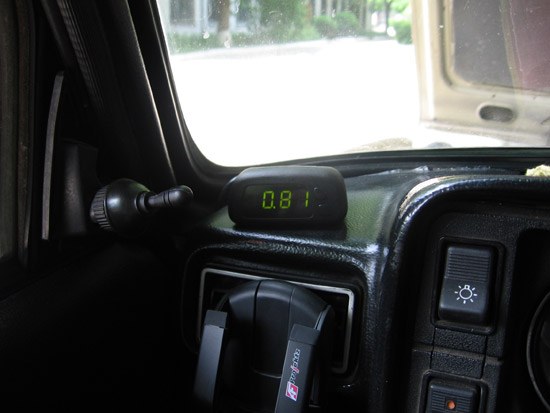
Applied to the vehicle idling, or idling, will be called engine operation with the clutch depressed or in neutral gear, when the torque of the crankshaft is not transmitted through the transmission to the cardan shaft, but from it, respectively, to the drive wheels. In both cases, the engine and wheels will be disconnected.
Normally, the idle speed of a stationary car is stable and is 800-1000 rpm. If it is less, then the engine will stall when the clutch is released, an increased number of revolutions will lead to excessive fuel consumption and accelerated wear of vehicle components.
Idle speed is regulated by several components and assemblies of the car. First of all, this is a fuel supply system, consisting of an injector on modern cars or a carburetor on older ones, which are units for mixing fuel with air, a fuel pump, electronic or mechanical sensors, a fuel pressure regulator and other components that do not directly affect the number crankshaft revolutions.
In addition, the number of revolutions is affected by the degree of opening of the throttle valve, which regulates the air supply to the engine, and the operation of the idle valve, which supplies air bypassing the throttle. In addition, you can increase the speed, including idling, by pressing the accelerator pedal.
Unstable engine idling can be caused by a number of factors. The first of these is the contamination of fuel supply units and assemblies with used engine oil, soot, impurities in gasoline and air passing through the filter grids of these units, often water is also found in the gas-liquid mixture, on which, as you know, internal combustion engines are not yet work. Also, the problem may be caused by a malfunction in the ignition system, especially the UOZ, poor (oxidized, loose) contacts of high-voltage wires and other factors.
Sources:
- Idling VAZ 2106
It is useful for the car owner to know why the idle speed is high. After all, this problem visits all cars quite regularly. At the same time, the causes of the phenomenon are the same everywhere. There are only a few variations on the theme. As a rule, the majority cars idle speed ranges from 650 to 1000 rpm. Anything more is a sign of a power system failure. And this problem should be fixed. Typically, such problems are accompanied by excessive fuel consumption, which has an extremely negative effect on the state of the car owner's wallet.
The main reason
Why high idle speed? Most often, the problem occurs due to an overly enriched mixture. At the same time, an excessive amount of air is supplied to the cylinders, which increases the engine speed to a certain limit. Upon reaching it, the engine chokes and starts to stall. After all, the amount of fuel is about the same. The reduced RPM allows the engine to continue running and pick up speed again. That is why the phenomenon of floating revolutions occurs.
But this is not always the reason. There may be other problems as well. Moreover, the variants of malfunctions differ for carburetors and injectors. Therefore, we consider the reasons in more detail.
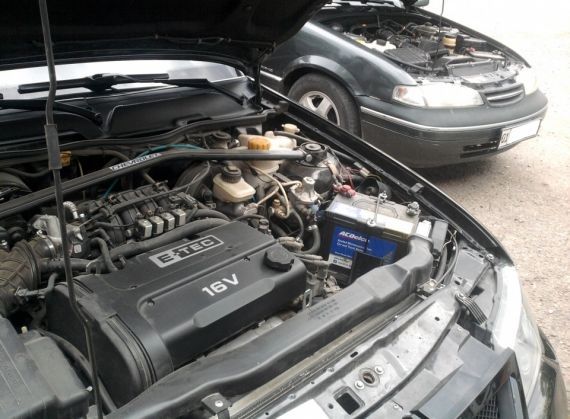
Carburetor
There are several reasons for this behavior of a carburetor engine. To effectively fix the problem, you need to work out all possible options. Just keep in mind that the carburetor is a rather complex system, and you need to set it up very carefully. The reasons for high idle speed are as follows:
- Violation of idle adjustment. Check how your carburetor is adjusted. Pay special attention to the screw responsible for the air supply. Make adjustments if necessary. Often this problem occurs after cleaning the carburetor;
- A choke valve that is not completely closed can also cause increased speed. It may not close due to damage or blockage. In the first case, you will have to change the carburetor, in the second case, it is enough to clean it;
- The throttle valve of the primary chamber does not close completely. With such a malfunction, the revolutions will be stably high, carrying any fluctuations. This can happen due to valve deformation or problems with the drive cable;
- Also, high rpm can be caused by an increased level of fuel in the float chamber. This occurs when the needle valve is stuck. Be sure to check this reason;
- Air leak. If the gasket under the carburetor is slightly damaged, an increase in speed may be observed.
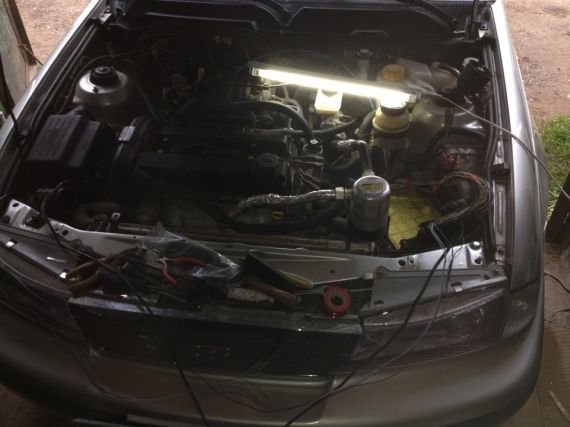
Injector
For injection engines, there are much more reasons why the speed is dancing. This is due both to problems in the mechanical part of the power system, and malfunctions with the sensors. Therefore, in order to find the reasons, it is necessary to conduct a thorough analysis of all options malfunctions:
- Most often, problems arise due to the sensor or the idle speed controller. With this malfunction, the revolutions in neutral can both disappear and increase;
- quite often causes an increase in the number of revolutions. In case of some failures, it gives incorrect readings, and the control unit gives incorrect commands to the injector;
- Problems with the cable that activates the throttle. Most often, he jams, which prevents him from returning to his original position. There may also be a problem with the return spring. Sometimes it jumps off, and the damper does not move back. This again causes an over-rev problem;
- A slightly less common problem is with the engine temperature sensor. In the normal state, it warms up the engine when it is cold. To do this, he gives the command to maintain increased speed. In the normal state, the sensor turns off the warm-up mode when a certain temperature is reached. If it fails, this does not happen, and the engine constantly operates in warm-up mode;
- Often the cause is air leakage into the intake manifold. There is a problem when the gaskets are damaged.
High idle speed. We solve this problem.
Over the entire period of operation of the machine from time to time (but especially in the heat), the engine speed increased by itself. Sometimes you don’t even press the gas, but she goes by herself. And even standing at a traffic light with a roaring engine was not very pleasant. Therefore, it was necessary to get rid of this problem, which I actually did.
After reading a long time ago a topic from Ruslan Ahmedlan, it became clear that the bad contacts in the wiring at the ECU or at the TPS and IAC were to blame. And that's when in Once again the speed jumped, I opened the hood and began to move the wires at the TPS and IAC, but this did not give a positive result. Then I moved the braid of wires at the ECU and the miracle speed immediately returned to normal. The reason has been found. But now the hands have reached the elimination of this cause only now. To begin with, I decided to try this method, that is, do not solder anything, but simply pulled the wires from the TPS and IAC from a common braid and laid them in separate corrugations. Of course, this is not so easy to do, but I no longer wanted to endure high speeds, so we get to work and do it slowly. This required corrugation d = 16mm (the smallest diameter I found in the store) and electrical tape, a lot of electrical tape.
The first step is to remove the battery for convenience and safety. Next, remove the connectors from the throttle position sensors and the idle speed controller. And already from them we begin to pull out the wiring from the common braid, first the wiring from one sensor, then from the second. Of course, you will have to remove all the interfering parts of the engine compartment, but there is no other way. When pulling out the wires from the common braid, I had to suffer with unwinding the electrical tape wound on the corrugation, but it was much more difficult to wind it back there, especially in the USR valve area. And that's what we did. Now we take a corrugation d = 16mm, cut off the desired length and cut along. We put the wires from the TPS into it and tighten the corrugation in places with ties, we do the same with the wires from the IAC. Next, we collect all the previously removed parts of the engine compartment, connect all the connectors, put the battery in and start it up. The turnover is normal, for the second day there is no hint of increased, we will observe further and unsubscribe if anything.
Thank you all and keep the engine running!
Common braid of wires
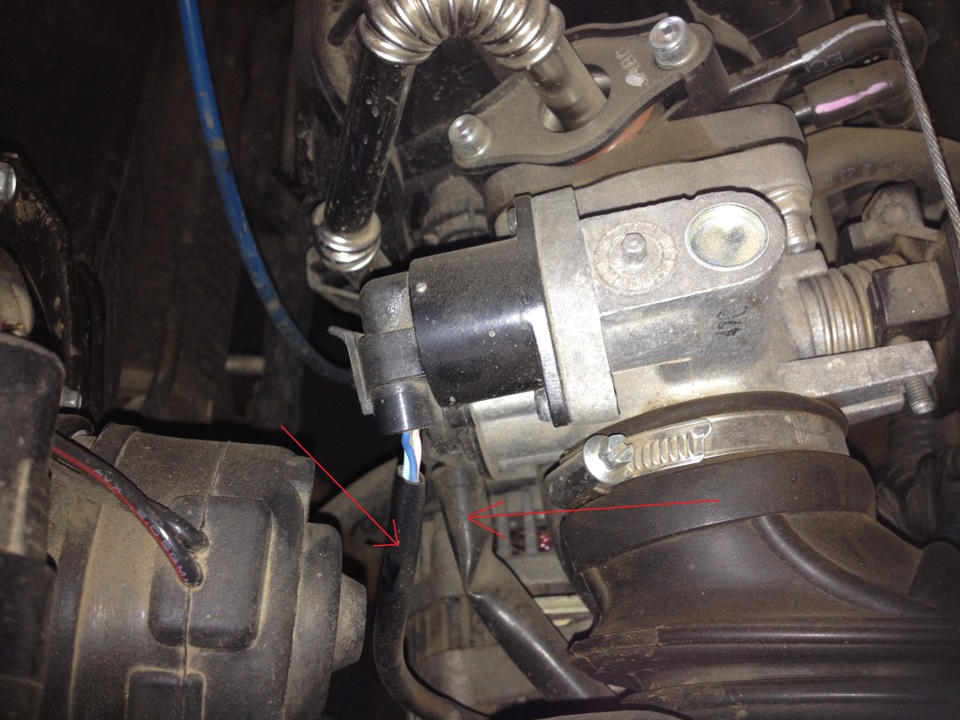
these two wires must be separated from the common braid

already separated
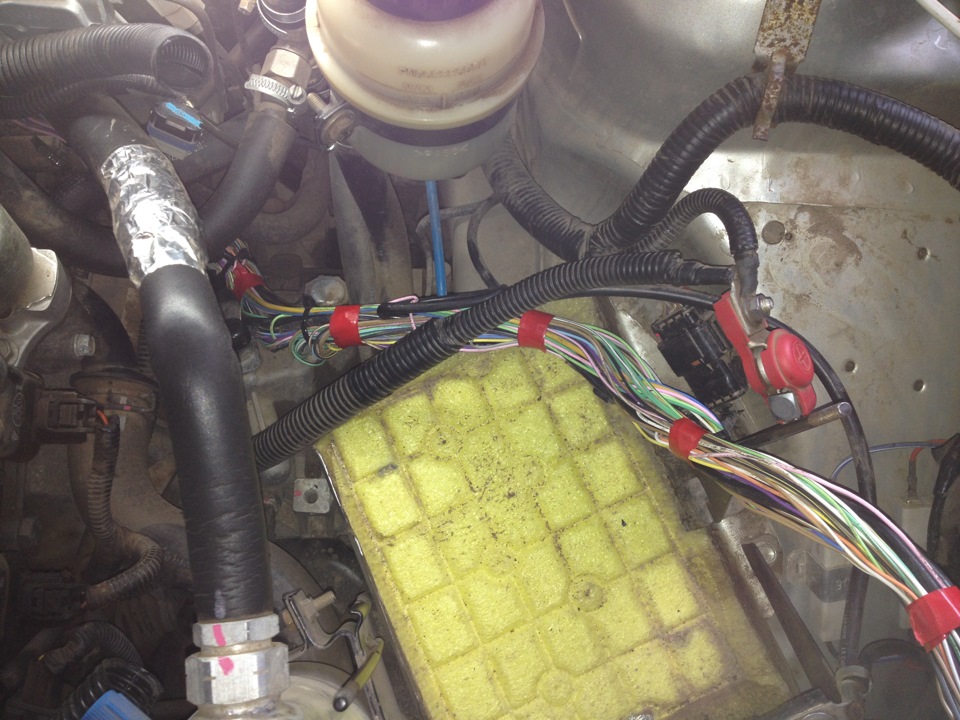
we collect the common braid back with electrical tape and ties

in progress

common braid of wires assembled
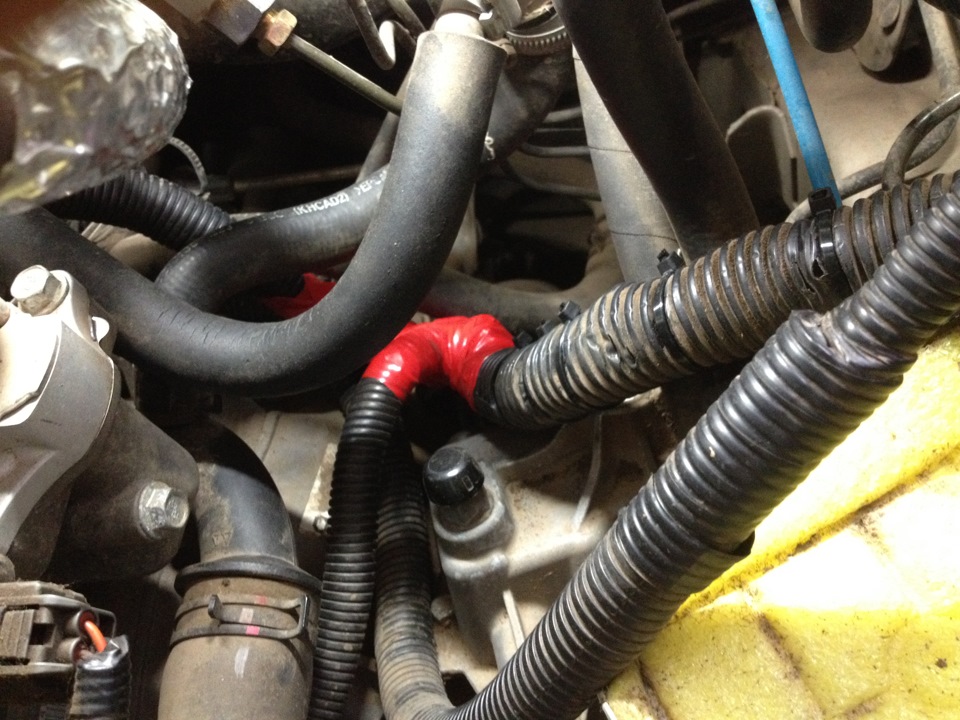
here it is not very easy to wind the tape

wires from TPS and IAC are already in separate corrugations
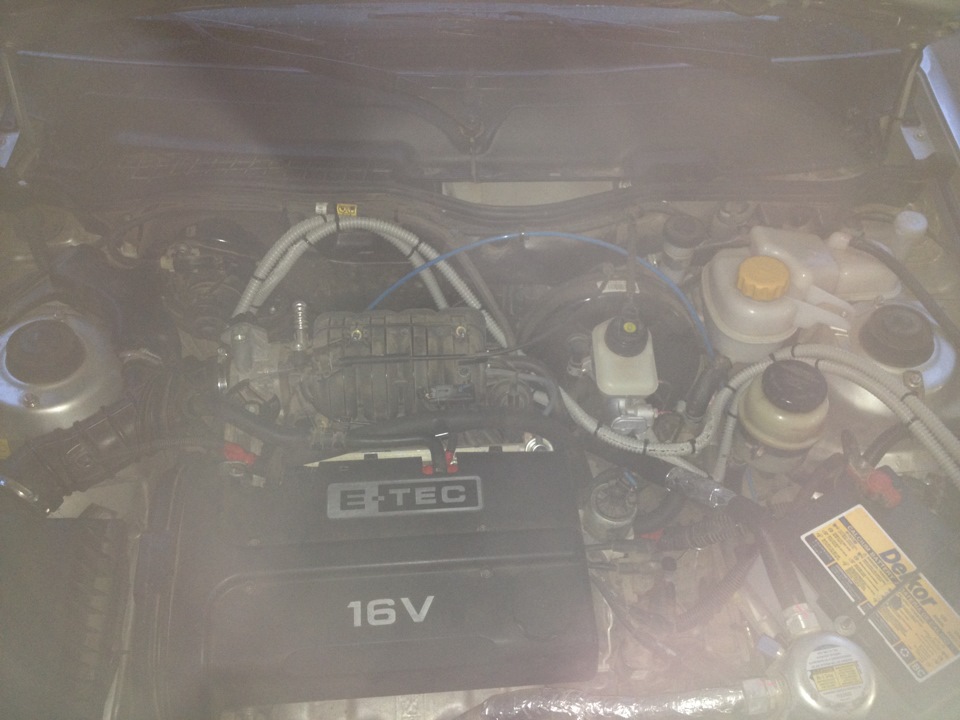
this is how I put them

corrugated wires
Addendum to the entry
September 2014. In less than two months, the increased speed again made itself felt ... I go to the garage and take everything back. I find a place to crimp the wires (in my case, the crimp was in one place), remove this crimp, slightly lengthen the wire, twist it and solder it with a soldering iron. We put heat shrink on the places of soldering. But I didn’t stop there, I decided to check the connector on the ECU itself. For a long time I could not figure out how to remove the connector, everything turned out to be simple. On the right there is, how to call it correctly, a locking handle (it is just under the ECU wiring), we pull this handle towards the left wing and the connector moves away from the ECU. When installing the connector, pull this handle towards the radiator grille.
So we removed the connector, we examine everything. Everything seems to be fine here. But for greater certainty, we take a needle and tighten the contacts of the TPS and IAC wires (7 contacts), we do this not much, since the needle may break. Further, on the ECU itself, we bend the contacts of the TPS and IAC a little, we do this with the help of round-nose pliers, and we do not bend the entire contact, but only its upper part.
We collect everything back and check, start - the speed is normal. I hope they don't bother me again.
Good luck to all!
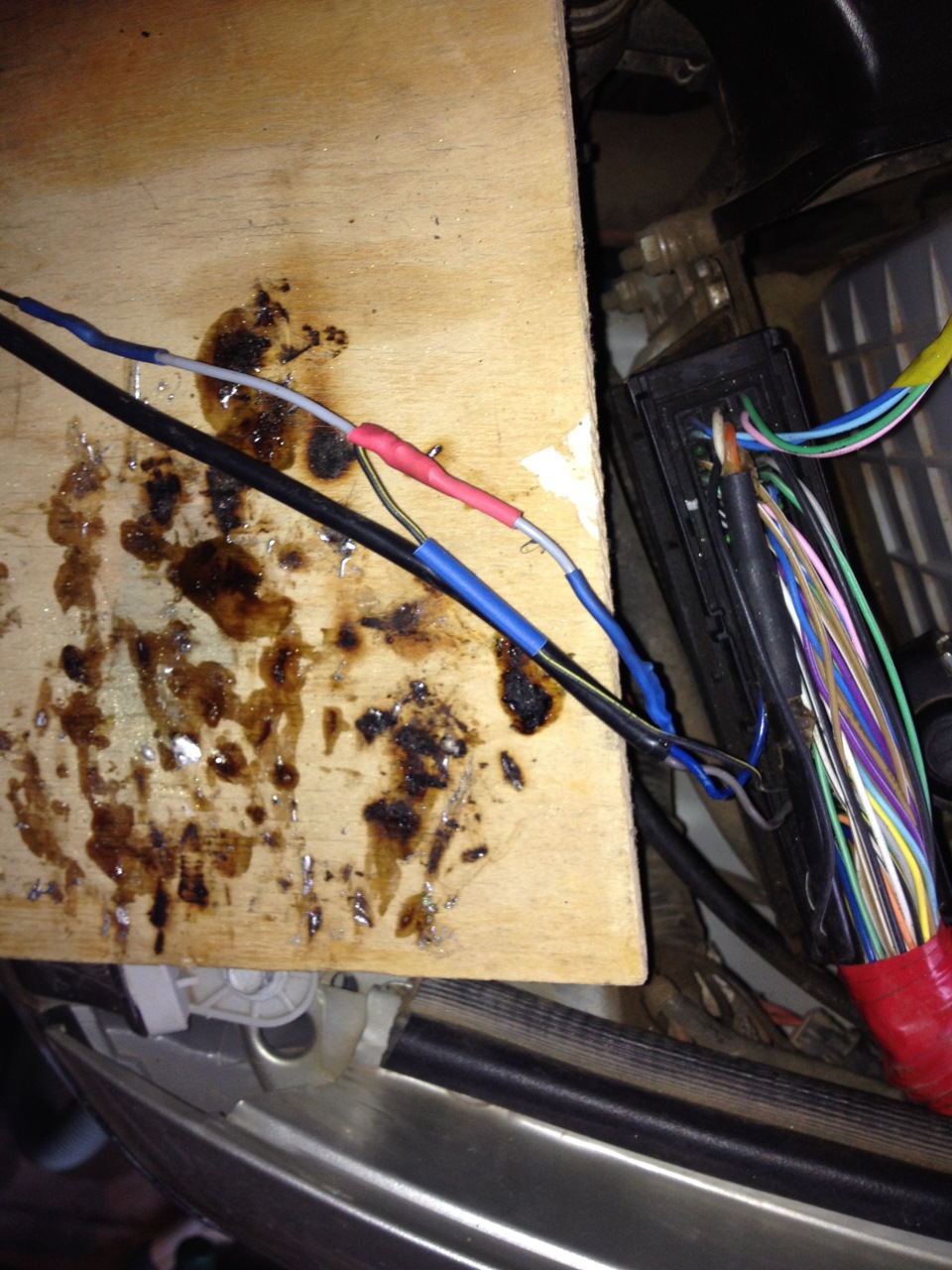
soldered wires

removed ECU connector (locking handle on the right under the red tape)
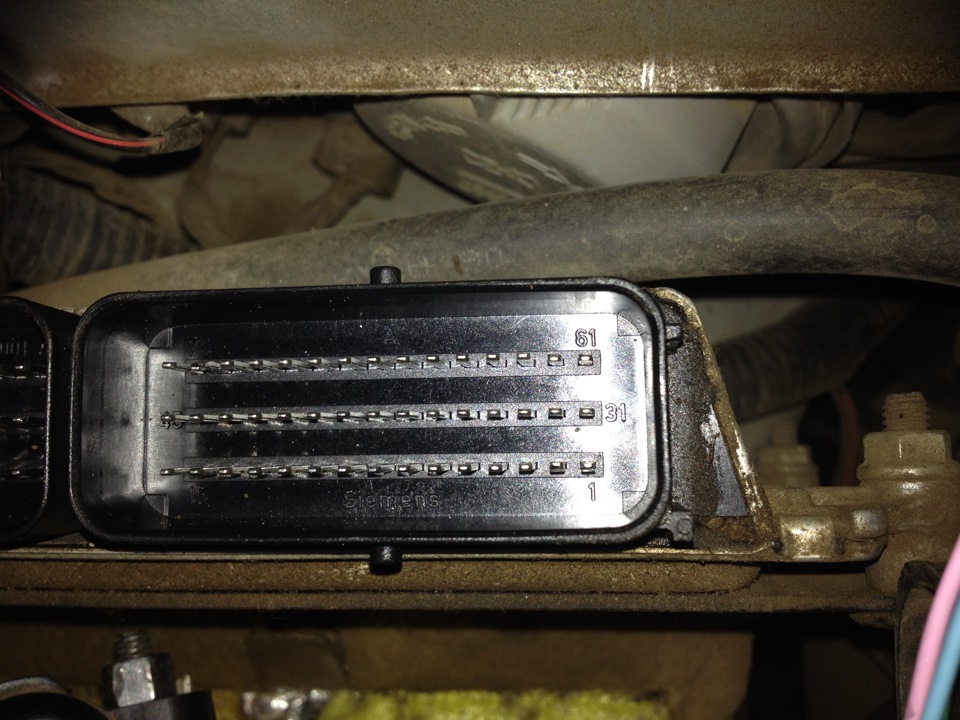
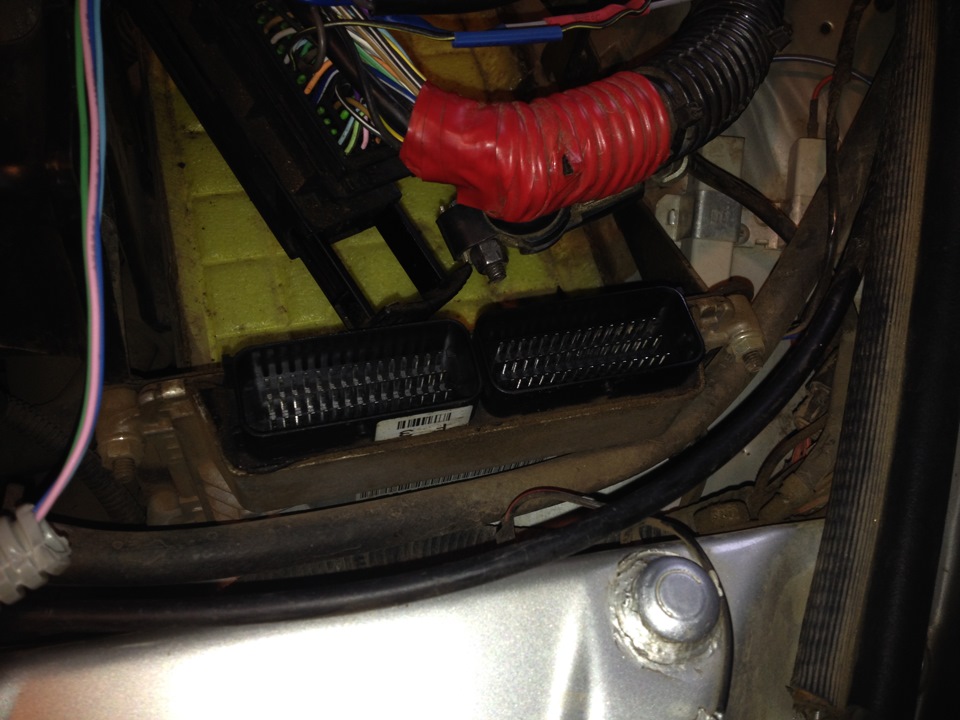
Auto-Translated Original (RU)
Daewoo Nexia DRIVEN TO PERFECTION › Logbook › High idle speed. Solve this problem.
During the entire operation of the machine from time to time (but especially in the heat) the engine's revolutions increased on their own. Sometimes you do not even press a gas on it, but it goes by itself. And even at a traffic light to stand with a roaring engine was not very pleasant.
After reading a long ago the topic www.drive2.ru/l/288230376153080754/ Ruslan Ahmedlan it became clear that the fault was caused by bad contacts in the wiring from the computer or from the DPDZ and RHH. And when, once again, the turns jumped, I opened the hood and began to stir wires at DPDZ and RXH, but this did not give a positive result. Then I wiggled the braid of wires from the computer and miracle speed immediately normalized. The reason was found. But here "s the hands until the elimination of this reason came only now. To start, I decided to try this method www.nexia-faq.ru/electro/…borotes-holostoy-hod.html, that is, I did not re-solder anything, but just pulled wires from DPDZ and RXH from the common spit and put them in individual corrugations. and do it slowly.
First of all, we remove the battery for convenience and safety. Next, remove the connectors from the throttle position sensor and idle speed controller. And already from them we start to pull out the wiring from the general braid, first the wiring from one sensor, then from the second one. Of course you have to remove all the interfering parts of the engine compartment, but otherwise neither. When pulling wires from the common spit, you had to torment yourself with the unwinding of the insulating tape wound around the corrugation, but it was much more difficult to rewind it there, especially in the area of the EGR clan. And we did it. Now take the corrugation d = 16mm cut off the desired length and cut along. We put wires into it from the DPDZ and tighten the corrugations in places with couplers, the same thing we do with the wires from the RXX. Next, we collect all the previously removed parts of the engine compartment, connect all the connectors, put the battery and start. Turnovers are normal, for the second day there is not a hint of increased, we will observe further and unsubscribe if that.
Thank you all and the smooth operation of the engine!
General plait of wires

these two wiring and must be separated from the general braid

already separated

we collect the common scythe back with the help of insulating tape and screeds


common helix is collected




